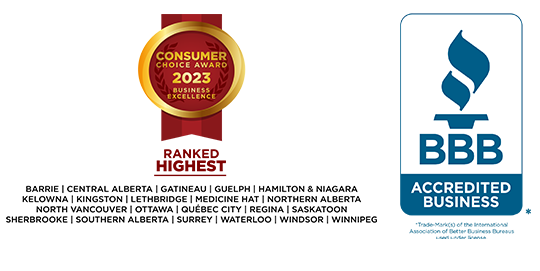Bankruptcy vs. Insolvency: Which one is right for you?
2023-06-01 4 minute read
In Canada, a handful of options exist for individuals who are exploring insolvency or Bankruptcy. The stress of financial difficulties can be lessened with the help of a Licensed Insolvency Trustee (LIT) to help you work through the realities of your unique situation and find the best outcome for you.

In Canada, a handful of options exist for individuals who are exploring insolvency or Bankruptcy. The stress of financial difficulties can be lessened with the help of a Licensed Insolvency Trustee (LIT) to help you work through the realities of your unique situation and find the best outcome for you.
The two main avenues are Bankruptcy and Insolvency. The key difference between them is that insolvency is a financial state in which a person is unable to make timely debt payments as they come due. Bankruptcy is a legal process that occurs when an individual declares that he or she is unable to repay their creditors.
The federal Bankruptcy and Insolvency Act (BIA) exists to protect all parties involved in Bankruptcy, including the debtor, lenders/creditors, and the LIT who coordinates, manages, and processes the filing.
According to the BIA, an insolvent person is defined as “a person who is not bankrupt and who resides, carries on business or has property in Canada, whose liabilities to creditors provable as claims under this Act amount to one thousand dollars, and
- (a) who is for any reason unable to meet his obligations as they generally become due,
- (b) who has ceased paying his current obligations in the ordinary course of business as they generally become due, or
- (c) the aggregate of whose property is not, at a fair valuation, sufficient, or, if disposed of at a fairly conducted sale under legal process, would not be sufficient to enable payment of all his obligations, due and accruing due; (personne insolvable)”
Bankruptcy is a structured legal process that allows you to have a financial fresh start. Indicators that you might want to file for Bankruptcy include maxed out credit cards, a plummeting credit score, compounding or growing debt, receiving harassing phone calls from creditors, etc.
Bankruptcy will get you out of debt in nine months and then will remain on your record for six years. Rebuilding your credit after filing Bankruptcy is the most critical part of the process to help you stay out of debt and develop solid financial habits moving forward.
How does a person go from being insolvent, to being bankrupt?
Typically, a person realizes they are insolvent either all at once, after a significant derogatory financial event, or over time, where it is slowly realized that the current debt repayment plan is not a viable way to pay the debt off.
If a person is insolvent and owes more than $1,000 in total, they qualify for declaring Bankruptcy in Canada, which may be a practical option for your situation. However, meeting this requirement does not mean you must file for Bankruptcy – other options can be explored with the help of a LIT.
Bankruptcy is an option for debtors looking to gain relief from their debts while ensuring that creditors are treated fairly. Another goal of the Bankruptcy process in Canada is the rehabilitation of the debtor through financial counselling.
Through Bankruptcy, a person burdened with debt receives a chance for a fresh start and a better financial future. Bankruptcy is not a punishment and while it can be difficult, it’s a constructive process.
The legal process of Bankruptcy features a “stay of proceedings” that prevents the garnishing of wages or of any legal action from taking place and stops your creditors from calling. Most first-time personal bankruptcies in Canada last nine to 21 months, depending on the debtor’s income and other factors.
Bankruptcy process and discharge
The Office of the Superintendent of Bankruptcy (OSB) is the Canadian government regulator who oversees the Bankruptcy process. Their website offers the following information about what is involved when filing for Bankruptcy:
When you file for Bankruptcy, you must do the following:
- Disclose to the LIT information about all of your assets (property) and liabilities (debts)
- Advise the LIT of any property that was sold or transferred (disposed of) in the past few years
- Surrender all your credit cards to the LIT
- Attend the first meeting of creditors (if a meeting is requested)
- Attend two counselling sessions
- Submit monthly income and expense reports, with proof of income
- Make a monthly payment
- Submit tax information, as requested
- Advise the LIT in writing of any address changes
- If required, attend an examination at the Office of the Superintendent of Bankruptcy; and
- Assist the LIT as needed in administering your estate.
Once these duties have been completed, you will be eligible for your discharge from the Bankruptcy.
A discharge releases you from the legal obligation to repay the debts you had as of the date you filed for Bankruptcy, except for specific types of debts that are excluded by law. These include alimony and child support payments, student loans (if you stopped being a student less than seven years ago), court-ordered fines or penalties, and debts arising from fraud.
The timing of your discharge depends on a number of factors, including whether this is your first bankruptcy, and whether you are required to make surplus income payments.
Timing of your discharge from bankruptcy (automatic discharge)
If this is your first Bankruptcy, and you are not required to make surplus income payments (because your surplus income is less than $200 per month), you will be eligible for an automatic discharge from Bankruptcy in nine months. If your surplus income is higher, your Bankruptcy will be extended to 21-months, and you will be required to make payments from your surplus income.
Your discharge from Bankruptcy will happen automatically if:
- The discharge is not opposed by the LIT, a creditor or the OSB.
- You have completed all of your duties.
- This is your first or second bankruptcy.
To ensure that a greater percentage of debts is repaid to creditors, the following standards set out when an automatic discharge will occur.
Timing of your discharge from bankruptcy (automatic discharge), First Bankruptcy
| First bankruptcy | Timing of discharge |
|---|---|
| Not required to make surplus income payments (surplus income is less than $200 per month) | Nine months after filing |
| Surplus income is greater than $200 per month | 21 months after filing |
Timing of your discharge from bankruptcy (automatic discharge), Second Bankruptcy
| Second bankruptcy | Timing of discharge |
|---|---|
| Not required to make surplus income payments (surplus income is less than $200 per month) | 24 months after filing |
| Surplus income is greater than $200 per month | 36 months after filing |
Duties in Bankruptcy
Bankruptcy is an involved process that takes time and consideration from all parties. There are necessary steps to take throughout the Bankruptcy to ensure it goes smoothly for all parties.
During Bankruptcy you will need to:
- File monthly reports with your LIT to monitor your income
- Attend two counselling sessions to discuss the causes of your financial difficulty and various debt management strategies for the future
- Give your LIT the information needed to complete your tax returns for the year you filed
- Pay any required amounts to your LIT, such as surplus income payments, payments to repurchase an asset or the minimum amount required to cover the cost of administration.
Rebuilding your credit
There will, inevitably, be a significant impact on your credit due to Bankruptcy. With your LIT, during your counselling sessions, you’ll come up with strategies and steps to take on the journey to rebuilding your credit back and improving your financial outlook for the long term.
You’ll want to review your credit report to assess your spending habits and determine what might have led to Bankruptcy in the first place.
From there, you’ll create a budget. Setting goals and seeing where your money goes each month is crucial for pinpointing areas where you can cut back or need to exercise more self-control.
Getting a secured credit card, and making payments on time, will demonstrate to creditors that you can manage your debt. Unlike normal credit cards, secured cards require a security deposit that the credit card company holds. The limit of the card is secured by your deposit. Making small purchased and paying the balance off each month will help improve your credit score.
Depending on your unique financial situation, there are myriad options to help you manage your debt. By connecting with a LIT, you’ll be better equipped to determine the right next steps for you and work towards financial freedom from debt.

